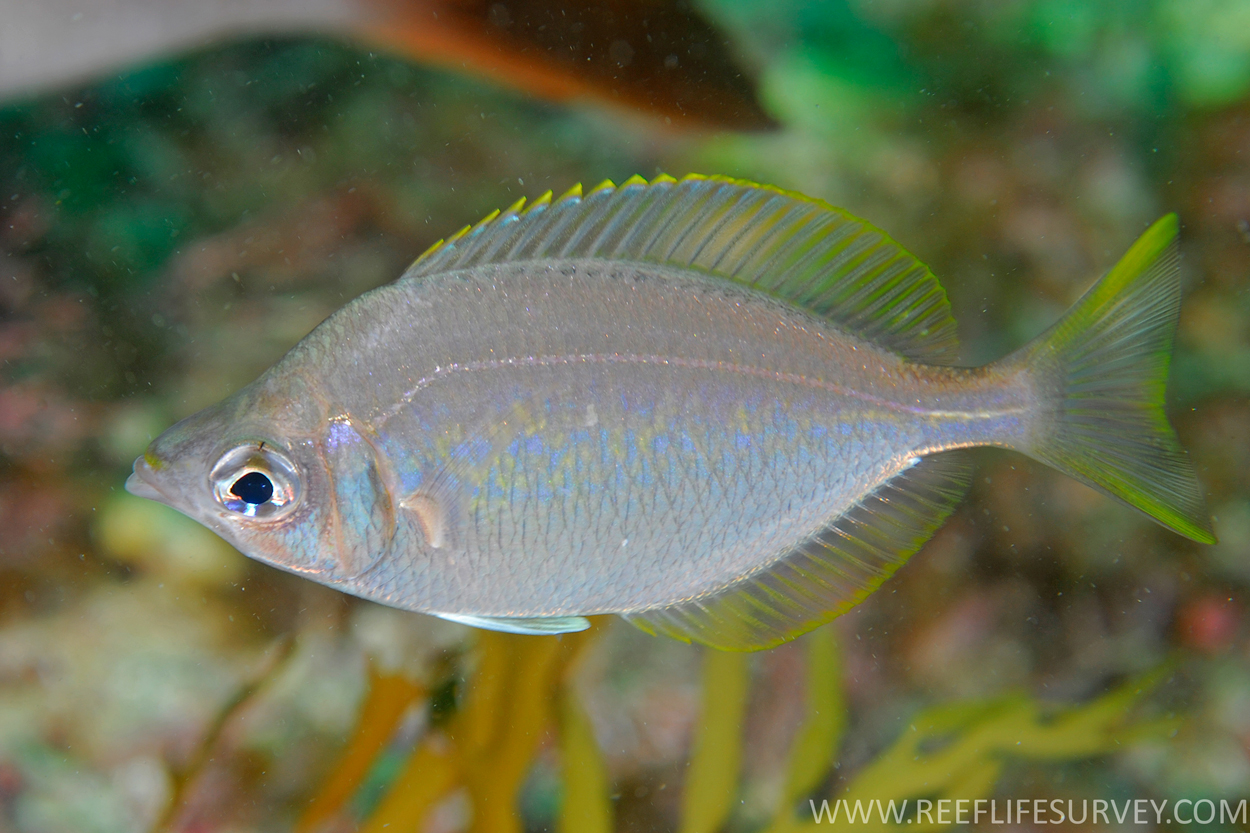- Classification
- ACTINOPTERYGII
- PERCIFORMES
- GERREIDAE
- Parequula
- melbournensis
Silverbelly, Parequula melbournensis (Castelnau 1872)

A Silverbelly, Parequula melbournensis, at Flinders Island, Tasmania. Source: Andrew J. Green / Reef Life Survey. License: CC BY Attribution
A silverbelly with a moderately deep semi-translucent to bluish body, a narrow yellow margin on the dorsal and anal fins, a narrow yellow vertical line on each membrane between the dorsal-fin spines and rays, 16-18 soft anal-fin rays, and 37-40 pored lateral line scales.
Silverbelly, Parequula melbournensis (Castelnau 1872)
More Info
|
Distribution |
Endemic to southern Australia, from Merimbula, New South Wales, to Rottnest Island, Western Australia, and around Tasmania, in depths of 0-100 m. The Silverbelly is common in shallow inshore waters, often swimming close to sandy or muddy bottoms, or amongst seagrass beds, from the intertidal zone to at least 100 m. Individuals can be solitary of form large schools. |
|
Features |
Dorsal fin IX, 16-17; Anal fin III, 17; Pectoral fin 14-15; Pelvic fin I, 5; Caudal fin 17; Lateral line scales 37-38. Body oval, compressed; snout short, pointed; mouth small with highly protrusible jaws; dorsal and anal fins long-based, dorsal fin low at front, higher towards rear; tail base slender, caudal fin slightly forked; scales cycloid, weakly attached. |
|
Size |
To 22 cm. |
|
Colour |
Overall whitish or a silvery-yellow, slightly darker and bluish above; fins translucent, dorsal fin slightly bluish with a yellow margin; upper and lower caudal-fin rays yellow. |
|
Feeding |
Carnivore - feeds on a range of invertebrates, including polychaete worms, molluscs, crustaceans and echinoderms. |
|
Fisheries |
Taken as bycatch in shallow trawl fisheries. |
|
Similar Species |
Differs from Parequula elongata in having a deeper semi-translucent to bluish body, with a thin yellow vertical line along the fin menbrane between the dorsal fin spines and rays; a yellow outer margin to the dorsal and anal fins; 16-18 soft anal-fin rays, and 37-40 pored lateral line scales. |
|
Species Citation |
Gerres melbournensis Castelnau 1872, Proc. Zool. Acclim. Soc. Vict. 1: 158 Type locality: Melbourne, Victoria. Australia |
|
Author |
Dianne J. Bray |
Silverbelly, Parequula melbournensis (Castelnau 1872)
References
Bruce, E., Deagle, B., Kirkwood, R., & Jarman, S.N. 2009. Analysis of Australian fur seal diet by pyrosequencing prey DNA
in faeces. Molecular Ecology 18(9): 2022–2038.
Castelnau, F. L. de 1872. Contribution to the ichthyology of Australia. No. 1. The Melbourne fish market (pp. 29-242). No. II. Note on some South Australian fishes (pp. 243-247). Proceedings of the Zoological and Acclimmatisation Society of Victoria 1: 29-247 plus 1 p. Errata.
Coleman, N. 1980. Australian Sea Fishes South of 30ºS. Lane Cove, NSW: Doubleday Australia Pty Ltd 309 pp. [158]
Edgar, G.J. 1997. Australian Marine Life. Revised Edition (2nd ed.) New Holland Publishers, Ltd, 544 pp
Gomon, M.F. 2008. Family Gerreidae (pp. 586-587) In: Gomon. M.F., Bray, D.J. & Kuiter, R.H (eds) Fishes of Australia's Southern Coast. Sydney : Reed New Holland 928 pp. [587]
Gomon, M.F., Glover, C.J.M. & Kuiter, R.H. (eds) 1994. The Fishes of Australia's South Coast. Adelaide : State Printer 992 pp. 810 figs [598]
Hoese, D.F. & Bray, D.J. 2006. Gerreidae, pp. 1212–1217 In: Beesley, P.L. & Wells, A (eds), Zoological Catalogue of Australia. Volume 35 Fishes. Parts 1–3. ABRS & CSIRO Publishing, Collingwood, 2178 pp.
Hutchins, J.B. & Swainson, R. 1986. Sea fishes of southern Australia. Swainston Publishing, Perth, 180 pp.
Hutchins, J.B. & Thompson, M. 1983. The Marine and Estuarine Fishes of South-western Australia. Western Australian Museum, Perth, 103 pp. 344 figs
Iwatsuki, Y., J.J. Pogonoski & P. Last. 2012. Revision of the genus Parequula (Pisces: Gerreidae) with a new species from southwestern Australia. Zootaxa 3425: 42–54
Kuiter, R.H. 1993. Coastal fishes of south-eastern Australia. Crawford House Press, Bathurst, University of Hawaii Press, Honolulu, 437 pp.
Kuiter, R.H. 1996. Guide to sea fishes of Australia. A comprehensive reference for divers and fishermen. New Holland Publishers, Sydney, 433 pp.
Last, P.R., Graham, A., Chidlow, J., Gledhill, D., Bray, D.J., Conboy, L., et al. 2006. A survey of the ichthyofauna of the continental shelf of south-west Australia. CSIRO Marine and Atmospheric Research, Hobart, 26 pp.
Last, P.R., Scott, E.O.G. & Talbot, F.H. 1983. Fishes of Tasmania. Hobart : Tasmanian Fisheries Development Authority 563 pp. figs [367]
Platell, M.E., Sarre, G.A. & Potter, I.C. 1997. The diet of two co-occuring marine teleosts, Parequula melbournensis and Pseudocaranx wrighti, and their relationships to body size and mouth morphology, and the season and location of capture. Environmental Biology of Fishes 49: 361–376.








